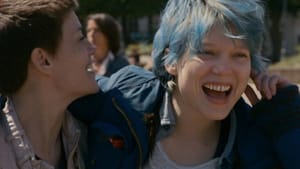Stay in the Loop
BSR publishes on a weekly schedule, with an email newsletter every Wednesday and Thursday morning. There’s no paywall, and subscribing is always free.
The view from Europe
'Blue Is the Warmest Color' and 'The Great Beauty'

Last year brought us two of the best European films in recent memory, both widely recognized and both now available on Amazon Prime and Netflix. Blue Is the Warmest Color and The Great Beauty make excellent companion pieces, presenting a surfeit of gorgeous filmmaking as they bookend two lives in advanced industrial democracies. Both are overlong western European films, replete with lush cinematography and the kind of blasé attitude toward nudity that has separated the United States from Europe since the 1960s at least. (Another, less laudable symmetry: All the nudity is female.)
The two films show two very different people: specifically, the beginning of one character’s life and the end of the other’s. The nearly ten-minute lesbian sex scene in Blue is probably what most who haven’t seen the movie associate with it. But it isn’t really about the love between two women: Léa Seydoux’s hip, arty intellectual is only shown when her life intersects with that of Adèle Exarchopoulos’s lower-middle-class student-turned-schoolteacher. Their relationship is one of the dominant aspects of the latter’s younger years, so a lot of time is given to their life together — hence the sex. But there are also ten-minute segments where we simply watch Exarchopoulos in the classroom, beginning her professional life. It’s her movie, the story of the beginning of her adulthood.
The Great Beauty is about the end of a life, in this case that of Jep Gambardella (Toni Servillo), a hard-partying, ever-classy journalist who wrote one novel almost 40 years ago and then sank into a morass of champagne and Campari. The romance that dominated Jep’s young life — what his Blue would have been about — haunts him, appearing periodically in flashback. But the memories are hazy, and he can no longer quite recall the things she used to say to him. Now he floats around making appearances at parties — the movie has some of the greatest ever filmed — art openings, and love affairs. The ambition to write a second novel is long gone. He describes his evening plans, for the night and his life, to a square acquaintance: “I’ll drink a lot, but not enough to get unruly. And when you are waking up, I’ll be climbing into bed.”
 Intoxication and melancholy
Intoxication and melancholy
The Great Beauty is best enjoyed after having a few: The booze will be intoxicating for the opening swirl of partying, while the melancholic stirrings of sobriety will bring out matching nostalgia as the film unfolds. That feeling, and the intoxication that preceded it, are poison — of a soothing sort — to Jep, who has not only allowed his ambition to fade, but his commitment to the well-being of his city and his country. “What’s the matter with nostalgia? It’s the only thing left for those of us who have no faith in the future,” one of his friends proclaims. Perhaps the future wouldn’t have looked so bleak had they attended more protests and fewer parties.
The problem is that Jep and his friends, who seem to have had political commitments at some point, have allowed decadence to eat away at their awareness of — and their willingness and ability to put forward an alternative to — the wretched, immoral conservatism epitomized by Silvio Berlusconi. The former Prime Minister’s name is never mentioned, but his specter haunts the film in the passing glimpses of the new elite who lack Jep’s culture but seem perfectly happy with the decadence, no matter who suffers for it. As New York University professor Stefano Albertini told NPR, The Great Beauty is set in “the circles of leftist Rome [where] the emptiness is as big as it is in the circles of the right. . . . It's not only a problem of an ugly right. . . . It's also the problem of an empty left."
In The Great Beauty, the personal is political, the characters’ decline matching that of Italian nation and political-intellectual culture. That is its great difference with Blue Is the Warmest Color, which is far more concerned with a person than people or place. The French film is provincial in both subject matter and setting (it is set in Lille, not Paris). Instead of sweeping vistas of an ancient city, we get close ups of Adèle eating pasta. Blue is all about her in a way that the preening Jep might well envy. It is also substantially less political. While Adèle is seen participating eagerly in an anti-austerity protest and an LGBTQ march, her actions are not meant to highlight anything substantive about the world-historical state of France. Instead the film has apparently been substantially depoliticized in comparison with its comic book source material, eliding the fraught question of her family’s reaction to her romance with a woman.
Blue Is the Warmest Color’s star has faded a bit in America due to its self-and Academy-inflicted Oscar shutout, the passage of time, and the endless controversies that swirled around the film. The Great Beauty easily won the Academy Award for best foreign film, perhaps because it’s a story about the kind of person Oscar voters can relate to. It is unfortunate that Blue was not allowed to compete in the Oscars, as moviegoers would have had a longer time to see it in theaters. But with a multitude of web platforms making them available for perusal, the opportunity isn't gone: These two would make a delightful pairing for a rainy April weekend.
Photo, above right: The Great Beauty, photo by Gianni Fiorito © 2013.
What, When, Where
Blue Is the Warmest Color. A film written by Abdellatif Kechiche and Ghalia Lacroix, directed by Abdellatif Kechiche.
The Great Beauty. A film written by Paolo Sorrentino and Umberto Contarello, directed by Paolo Sorrentino.
Sign up for our newsletter
All of the week's new articles, all in one place. Sign up for the free weekly BSR newsletters, and don't miss a conversation.

 Jake Blumgart
Jake Blumgart